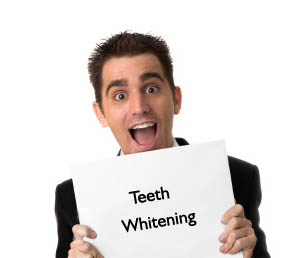Everyone wants white teeth.

A shiny white smile is very noticeable in a person.
Well today you can have a sparkling white smile in just 60 minutes.
Modern dentists make use of a revolutionary method using a special device that makes the whole procedure painless, and rather fast.

You can gain up to 8 shades of white on your teeth in one session only, and if you are not satisfied with the result you can always repeat the procedure in a few days and get the color you always wanted! The result does not fade quickly, your teeth will remain white for at least one year, and there is no damage to your teeth enamel whatsoever.
Bleaching makes our teeth whiter, brighter and of course more beautiful than before. But there is a small misunderstanding in the
whole bleaching issue. We are not making our teeth whiter, we are not painting them.
What happens here is that we make our teeth reflect more light with the bleaching procedure; that is what makes our teeth look so bright.

All this is fine, but how can we achieve this?
There are many products in the market that claim to do the job, but not everything that shines is gold.
For example all these “whitening” toothpastes that claim to whiten teeth are all just a marketing gimmick. Just think about it. We brush our teeth maximum for three minutes. A bleaching takes about one hour to achieve a good result. One hour of exposure on a certain paste (gel). How can toothpastes that are on our teeth for maximum three minutes actually do something to whiten
them? It is at least absurd. You can understand this better learning about the whole bleaching mechanism and how it works.
In order to bleach teeth we use hydrogen peroxide (H2O2). It is the best material and also the common one used in the world for tooth bleaching. There are two ways to bleach your teeth. The first one is the simplest one. It is done at home.
The dentists makes two special trays and the patient is using them with a special whitening paste (10% of H2O2) at home for an hour a day during a week’s time (try doing the same with a whitening toothpaste… a total waste of time and no actual result!). The second way is tooth bleaching in the dentist’s office. First of all the dentist isolates the patient’s gums because the bleaching gel is quite harmful for the gums (usually 33% H2O2).
Then comes the placing of the bleaching gel on the teeth and voila in 60 minutes – more or less – you have whiter teeth. The result depends on the amount of time that your teeth will be exposed on the whitening gel, the acceleration method used and of course the initial teeth color.
These two methods don’t really differ that much, but the in office method is more efficient, quicker and less troublesome. Whichever way you choose to whiten your teeth with (at home or in office), the result is more or less the same,
and your teeth will look whiter. However if you still do not like your tooth’s whiteness and you want them even whiter you can always repeat the procedure and make your teeth even whiter. Even though your teeth can be bleached, the same does not go for fillings and crowns.
If there are such restorations in your mouth then you have to replace them after the bleaching so that all your teeth look the same color. Ok, so you have done the tooth bleaching and you are satisfied with the result. What you have to look after now is to maintain this color.
How do I maintain the whitest color of my teeth following the proceedure?
The first three days are quite crucial. You have to be careful with your food and drinks. Coffee, alcohol based drinks (like whiskey, bourbon and brandy) have very strong color agents. The same goes for carrots, tomatoes etc. Bleaching gel manufacturers suggest staying away from all color products for three days and consuming only “white” products: dairy products, white cheese, chicken, white bread, white wine etc. In any case even though you take really good care of your teeth, you have to understand that tooth’s bleaching does not last forever.
It is a procedure that wears through time. So you have to repeat the procedure once or twice a year as well as keep our “bad” habits – alcohol, smoking coffee – under restriction. Let’s not forget that “whitening” toothpastes can help maintain the final bleaching result. It is up to you to decide when you want to repeat the process, but if you want the result to remain the same you must repeat the bleaching process every 6 months or so.
Can tooth bleaching or tooth whitening harm our teeth?
The answer is probably not. And I say probably because there is a small amount of hard tissue that gets damaged, but this damage is even less than the damage we create during our daily teeth brushing and cleaning. Bleaching is a safe and well researched procedure. Now we come to the outcome.
What happens after we perform a teeth whitening procedure?
Well sometimes there is some teeth sensitivity, temporarily for 24 hours but after that everything returns to normal. Some of the gum tissue can have white bleaching spots. This is the result of getting bleaching gel on the gums. There is nothing to worry about; this goes away in more or less 20 minutes.
So there you have it; tooth’s bleaching is safe, quick and can get your teeth as white as you want them to be.
One popular idea is to have your teeth bleached before, after or even during your holidays in Greece or the Greek islands.
If you have any questions on tooth bleaching please contact one of our listed tooth bleaching professionals in Greece.
